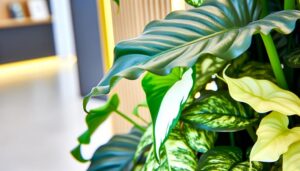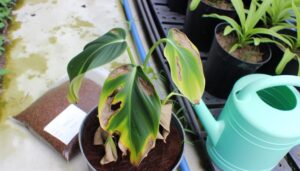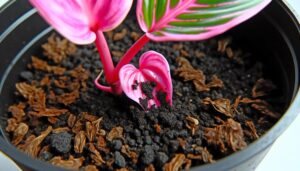What Are the Steps for Propagating Philodendron Brandtianum?
To propagate Philodendron Brandtianum, follow these steps. Gather sterilized pruning shears, a clean container, rooting hormone, and necessary protective gear.
Select a healthy, mature plant with multiple nodes, choosing the best growing season. Prepare your tools and select a healthy stem with nodes and leaves.
Make a precise cut and remove the lower leaves, exposing the nodes. Apply rooting hormone evenly, tapping off excess.
Prepare a soil mix with proper drainage and insert the cutting, submerging a node and maintaining an upright position. Water evenly, maintain humidity and provide adequate light.
Monitoring growth conditions is critical. For detailed insights, continue exploring.
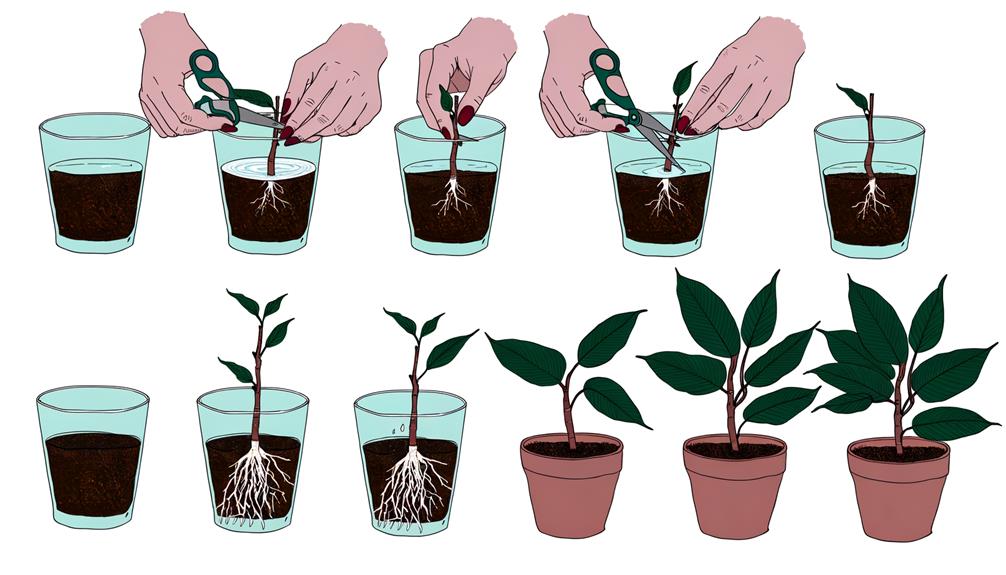
Key Takeaways
- Select a healthy Philodendron Brandtianum stem with multiple nodes and leaves.
- Use sterilized pruning shears to make a precise cut below a node.
- Remove the lower leaves, keeping one or two at the top.
- Dip the cut end into rooting hormone and tap off the excess.
- Insert the cutting into prepared soil mix, water evenly, and maintain humidity.
Gather Necessary Materials
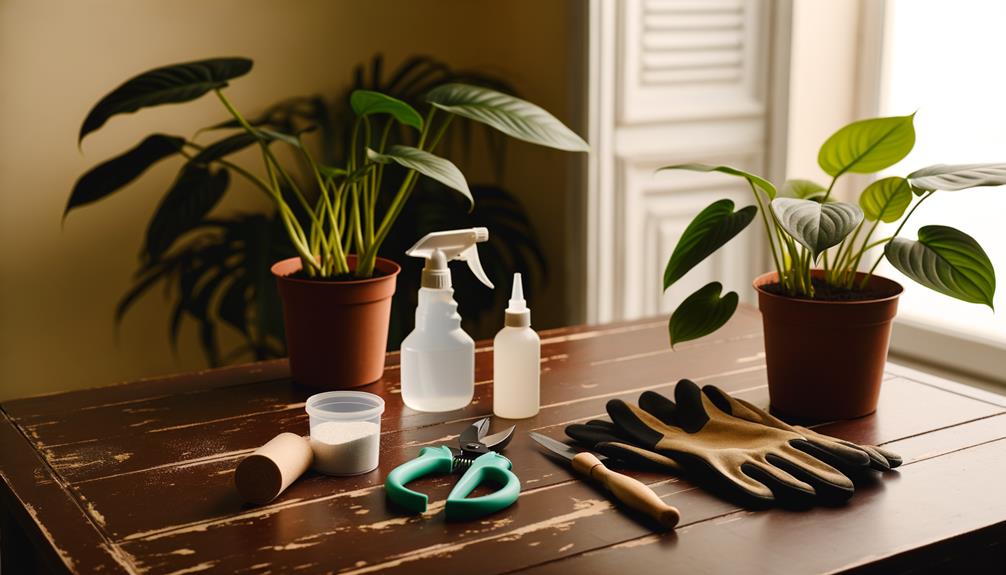
To start propagating Philodendron Brandtianum, gather the necessary items, including sterilized pruning shears, a clean container with water or soil, rooting hormone, and appropriate personal protective gear. Sterilized pruning shears are crucial to prevent the introduction of pathogens.
Use a clean container, either filled with water or a well-draining soil mix, to house the cuttings. Rooting hormone, available in powder, gel, or liquid form, boosts root development and should be applied to the cut end of the cutting.
Personal protective gear, such as gloves and eye protection, ensures safety during the propagation process. Making sure all tools and materials are properly prepared will set the foundation for successful propagation of Philodendron Brandtianum.
Select Healthy Parent Plant
After preparing your tools and materials,
focus on identifying a healthy parent plant, which is essential for guaranteeing strong and successful cuttings.
Select a Philodendron Brandtianum specimen exhibiting vibrant, unblemished leaves, and consistent growth patterns. Make sure the plant is free from pests, diseases, and any signs of stress, such as yellowing or wilting foliage. Inspect the stems for firmness and avoid any that appear mushy or discolored.
Ideally, the parent plant should be mature, as younger plants may not provide viable cuttings. Additionally, verify that the plant has multiple nodes, as these will be the points for new root development.
A careful selection of a vigorous parent plant sets the foundation for successful propagation.
Choose the Right Time
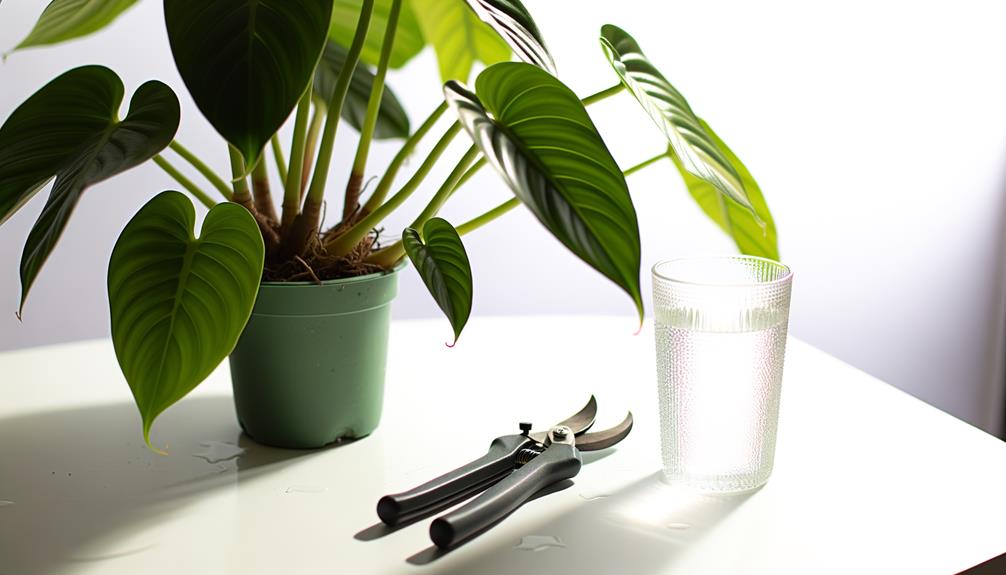
To guarantee successful propagation of Philodendron Brandtianum, it is essential to select the best growing season. This is typically during spring or early summer when the plant's growth rate is highest.
The parent plant should be mature enough, generally at least one year old, to provide viable cuttings. Additionally, consider weather conditions to maintain a consistent, warm environment conducive to root development.
Optimal Growing Season
The best period for propagating Philodendron Brandtianum is during the spring or early summer when the plant's growth is most vigorous. This season provides ideal conditions for root development and overall plant vitality. During these months, increased daylight and warmer temperatures support rapid growth and recovery post-propagation. It is important to monitor environmental factors such as humidity and temperature closely to guarantee successful propagation.
| Season | Reason for Best Conditions |
|---|---|
| Spring | Enhanced daylight, moderate temperatures |
| Early Summer | Peak growth phase, abundant sunlight |
| Late Summer/Fall | Less ideal, reduced growth rates |
Selecting the appropriate season ensures the plant's natural growth cycle aligns with propagation efforts, thereby maximizing success rates. Proper timing is vital for achieving robust and healthy new plants.
Ideal Plant Maturity
Identifying the appropriate maturity of the Philodendron Brandtianum is crucial for successful propagation, as mature plants exhibit more robust growth and root development potential. Select a mother plant that is at least one year old, showing healthy, vigorous growth with multiple leaves and well-established roots.
Examine the plant for the presence of mature nodes, which are essential for propagation success. These nodes should be visibly swollen and free from any signs of disease or pest infestation.
Make sure that the chosen plant section includes at least two to three leaves and one or more growth nodes. This will improve the likelihood of successful rooting and subsequent growth, providing a strong foundation for a new, thriving Philodendron Brandtianum.
Weather Conditions Considerations
Timing the propagation of Philodendron Brandtianum is vital, as ideal weather conditions greatly influence root development and overall plant health. The best period for propagation coincides with the plant's active growth phase, typically in spring or early summer. During these months, ambient temperatures and humidity levels are conducive to rapid root formation and robust growth.
Maintain a stable environment between 70-85°F (21-29°C) to promote cellular activities essential for root development.
Keep humidity levels around 60-70%, as high moisture content in the air minimizes the risk of desiccation.
Provide bright, indirect sunlight to stimulate photosynthesis without causing stress from excessive heat or light intensity.
These conditions collectively improve the success rate of propagation efforts.
Prepare Your Tools
To guarantee successful propagation of Philodendron Brandtianum, begin by gathering all necessary supplies, including sharp pruning shears, a clean container, and rooting hormone.
Next, sterilize your cutting tools to prevent contamination and disease transmission. Use isopropyl alcohol or a diluted bleach solution for effective sterilization.
Gather Necessary Supplies
Before beginning the propagation process for Philodendron Brandtianum, make certain you have gathered all necessary tools and supplies to facilitate a smooth operation. Proper preparation guarantees efficiency and success in propagation. Here are the essential items you will need:
- Sharp Pruning Shears: A precise tool for making clean cuts on the plant stem, minimizing damage.
- Rooting Hormone: Enhances root development by stimulating growth at the cut site.
- Propagation Medium: A well-draining medium, such as perlite or a mix of peat and sand, to support root formation.
Having these supplies ready will streamline the propagation process, ensuring each step can be executed without interruption. Attention to detail in preparation will markedly influence the success rate of your propagation efforts.
Sterilize Cutting Tools
Assure the cutting tools are meticulously sterilized to prevent the introduction of pathogens and maximize the success rate of the propagation process. Begin by selecting a sharp, clean pair of pruning shears or a sterile knife.
Immerse the cutting tools in 70-90% isopropyl alcohol or a 10% bleach solution for a minimum of 5 minutes. Alternatively, tools can be flamed using a lighter or alcohol burner until red-hot, guaranteeing complete sterilization.
After sterilizing, allow the tools to cool and dry completely before proceeding. Sterilization minimizes the risk of disease transmission and ensures the cuttings remain healthy. Repeat the sterilization process if the tools come into contact with any unsterilized surfaces during use.
Take a Stem Cutting
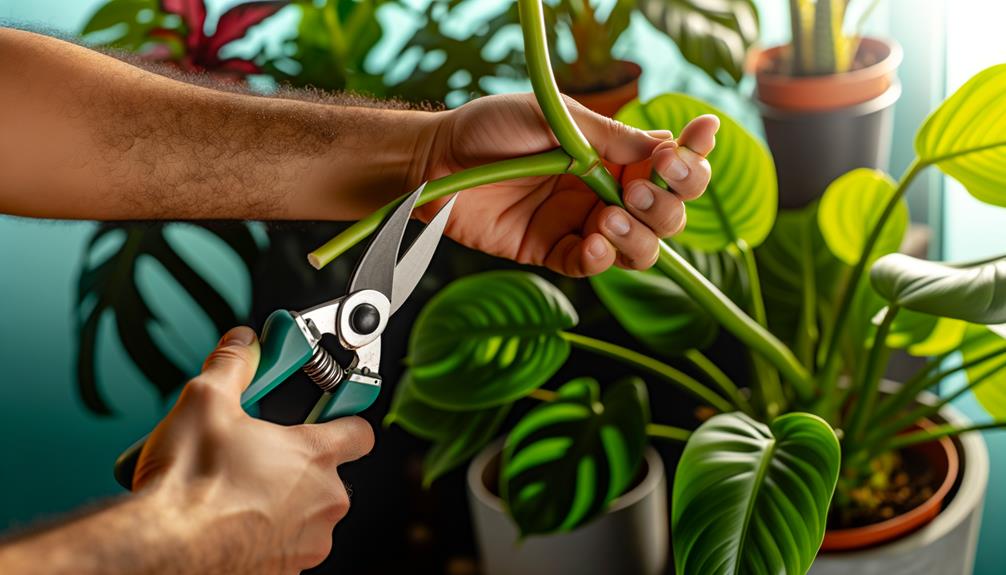
Choose a healthy stem with at least two nodes and a few leaves to guarantee successful propagation. Utilize sterilized cutting tools to make a precise cut just below a node, ensuring no harm to the plant's vascular tissues. A sharp, clean cut reduces the risk of infection and promotes faster rooting.
Identify the Cutting Point: Locate a node, the small swelling where leaves and aerial roots emerge.
Angle of Incision: Make the cut at a 45-degree angle to maximize the surface area for rooting.
Length of Cutting: Verify the cutting is 4-6 inches in length for best growth potential.
These steps are critical in preparing a viable stem cutting that will successfully develop into a new Philodendron Brandtianum plant.
Remove Lower Leaves
Carefully strip away the lower leaves from the stem cutting, ensuring that at least one or two leaves remain at the top to support photosynthesis and new growth.
Utilize sterilized pruning shears or a sharp knife to make clean cuts, minimizing potential damage and reducing the risk of infection.
Remove leaves by cutting them as close to the stem as possible without injuring the node, which is vital for root development. This step exposes the nodes, which are the primary sites for root formation.
Eliminating excess foliage reduces moisture loss and directs the plant's energy towards root establishment.
Handling the cutting delicately is necessary to prevent bruising or other mechanical damage that may impair successful propagation.
Apply Rooting Hormone
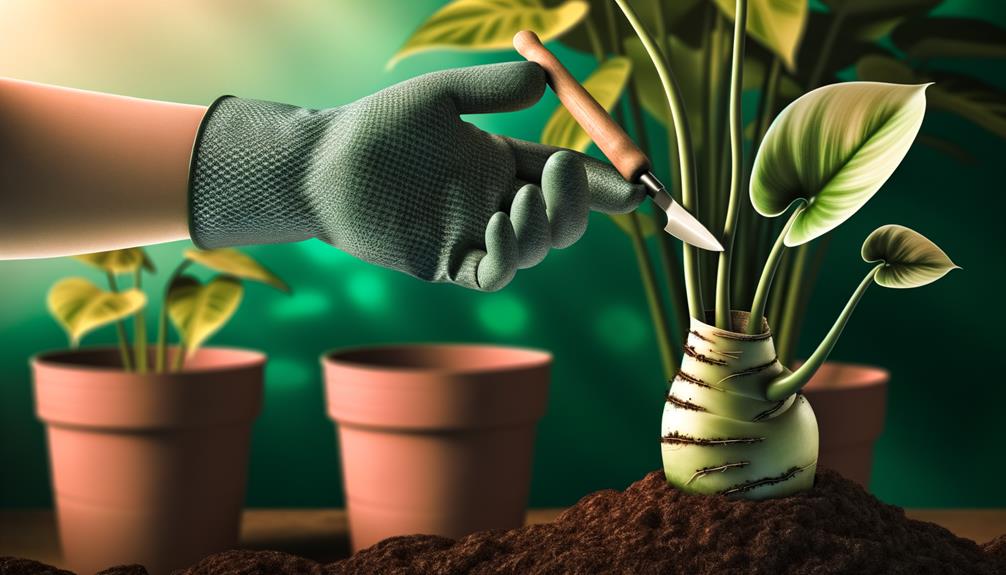
Applying rooting hormone to the freshly trimmed stem can improve root development and increase the success rate of propagation. Rooting hormones contain auxins, which promote root growth and expedite the formation of a strong root system.
To apply the hormone effectively, follow these steps:
- Preparation: Make sure that the cutting tools are sterilized to prevent contamination. Use a sharp knife or pruning shears to make a clean cut.
- Application: Dip the trimmed end of the stem into a rooting hormone powder or gel. Ensure that the hormone evenly coats the trimmed surface.
- Excess Removal: Tap off any extra hormone to avoid oversaturation, which can impede root development.
Plant the Cutting
To properly plant the cutting, first prepare a well-draining soil mix tailored for tropical plants.
Subsequently, insert the cutting into the soil at a depth sufficient to support its structure.
Prepare the Soil
Before planting the cutting, make certain the soil mixture is well-draining and rich in organic matter to promote best root development. An optimal soil blend guarantees proper aeration while retaining essential moisture.
A recommended mix is composed of the following components:
- Peat moss: Enhances moisture retention and provides organic nutrients.
- Perlite: Improves drainage and soil aeration, preventing root rot.
- Composted bark: Adds organic matter, improving soil structure and fertility.
Ensure that the soil is uniformly mixed before filling the planting container, maintaining a balanced ratio of each component. This combination will create an ideal environment for the Philodendron Brandtianum cutting to establish strong roots and thrive.
Avoid waterlogging by confirming the container has adequate drainage holes.
Insert the Cutting
Gently insert the Philodendron Brandtianum cutting into the prepared soil mixture, making sure that at least one node is submerged to facilitate root development.
Position the cutting vertically, guaranteeing stability by firming the soil around the base. Utilize a sterile tool to create a hole in the soil, minimizing damage to the cutting.
The node's placement is crucial as it contains the meristematic cells necessary for new root formation. Maintain a gap of approximately 2 inches between multiple cuttings to prevent overcrowding, which can impede growth.
Confirm the cutting is upright and supported, avoiding any tilting that may stress the developing roots. This meticulous insertion process is essential for the successful establishment and subsequent growth of the Philodendron Brandtianum.
Water and Monitor
After securely positioning the cutting, thoroughly water the soil to make sure it is evenly moist, facilitating peak root development and minimizing transplant shock. Proper hydration is critical during the initial stages of propagation to promote robust root system establishment.
Monitor the cutting meticulously by adhering to the following guidelines:
- Humidity Control: Maintain high humidity levels, ideally around 60-70%, using a humidity dome or regular misting.
- Light Conditions: Place the cutting in bright, indirect light to stimulate growth without causing leaf burn.
- Temperature Regulation: Ensure ambient temperatures remain between 70-80°F (21-27°C) to promote best growth conditions.
Regularly inspect for signs of new growth and potential issues such as fungal infections or pest infestations.
Provide Proper Lighting
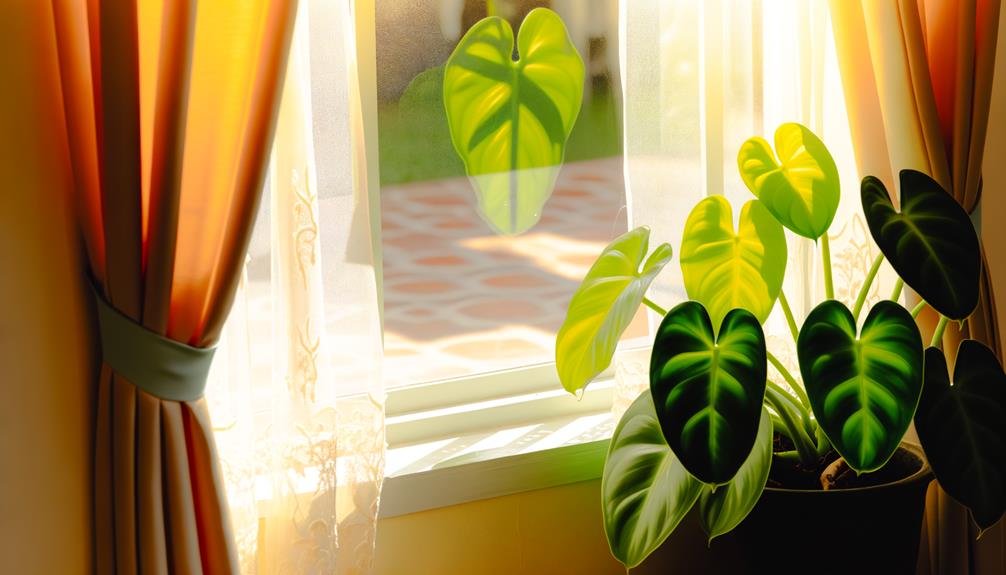
To achieve peak growth, Philodendron Brandtianum requires indirect, bright light, avoiding direct sunlight which can scorch its leaves. Ideal placement involves situating the plant near an east or north-facing window, where it receives ample ambient light without exposure to harsh rays. Use sheer curtains if the light is too intense.
For propagation under artificial lighting, employ full-spectrum LED grow lights, maintaining a distance of 18-24 inches from the plant. Maintain a photoperiod of 12-14 hours daily to mimic natural conditions. Regularly rotate the plant to promote even growth and prevent phototropism.
Monitor light intensity with a light meter, aiming for 1500-2500 foot-candles. Proper lighting is crucial to foster healthy root development and robust foliage expansion.
Maintain Humidity Levels
Promoting ideal moisture levels, ideally between 60-80%, is crucial for the successful propagation of Philodendron Brandtianum. High moisture levels support optimal root development and prevent desiccation of the cuttings.
To sustain these conditions, consider the following methods:
- Moisture Trays: Place a shallow tray filled with water and pebbles beneath the propagation container to increase ambient moisture.
- Spraying: Regularly spray the cuttings with distilled water to maintain surface moisture without causing waterlogging.
- Moisture Domes: Utilize clear plastic domes or bags to create a microenvironment that traps moisture around the cuttings.
Implementing these strategies will create a favorable environment for root formation and overall plant health during the propagation process.
Monitor Growth Progress
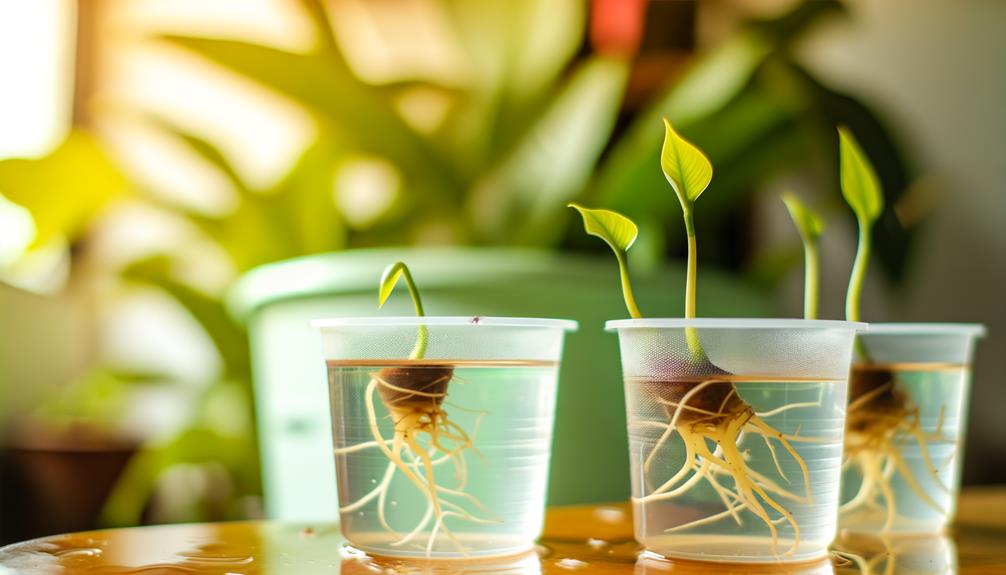
Once ideal humidity levels have been established, it is essential to systematically monitor growth progress to achieve successful propagation. Begin by inspecting the cuttings daily for signs of root development and new leaf growth.
Use a magnifying glass for precision in detecting minute changes. Maintain the growing medium remains moist but not waterlogged, adjusting watering frequency as needed.
Document observations in a dedicated log, noting any deviations from expected growth patterns. Regularly check for pests or diseases, promptly addressing any issues.
Employ a consistent light source, providing 12-14 hours of indirect light daily. Adjust environmental conditions as necessary based on observed growth responses.
This meticulous approach ensures optimal conditions for the Philodendron Brandtianum to thrive.
Conclusion
To sum up, the propagation of Philodendron brandtianum, when carried out accurately, enhances the potential for successful growth to a large extent. According to horticultural studies, stem cuttings from healthy parent plants have an 85% success rate in developing robust root systems under ideal conditions.
This high success rate highlights the importance of meticulous adherence to each step of the propagation process, from selecting the right time to maintaining appropriate humidity levels, thereby ensuring vigorous and healthy new plants.


